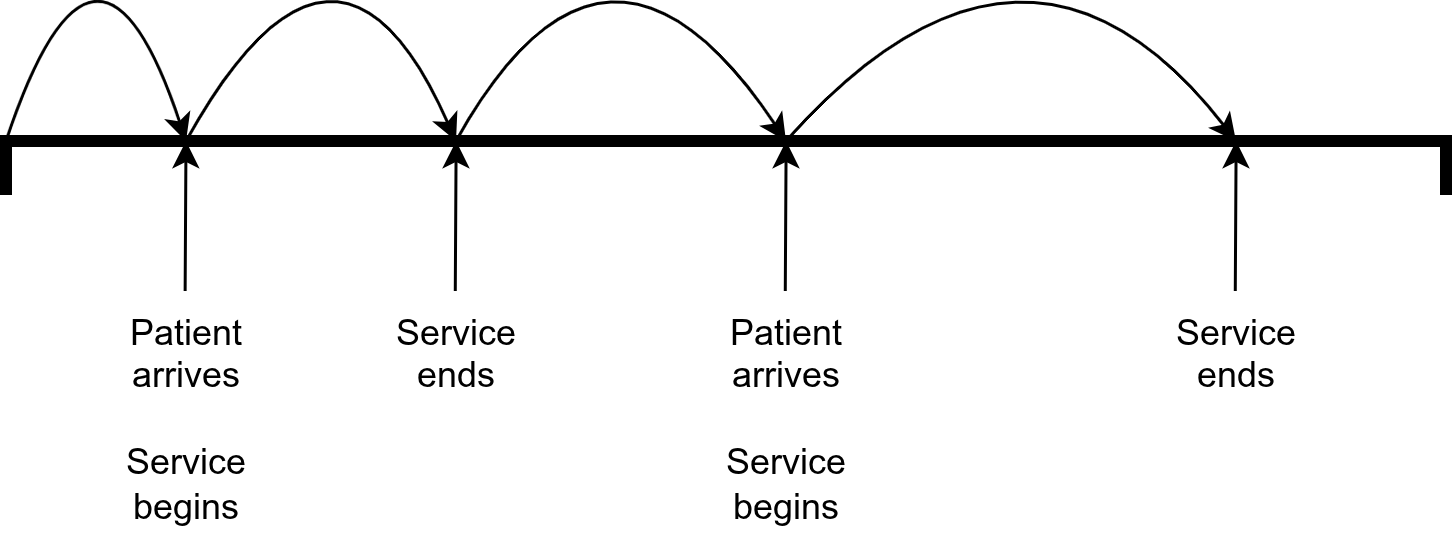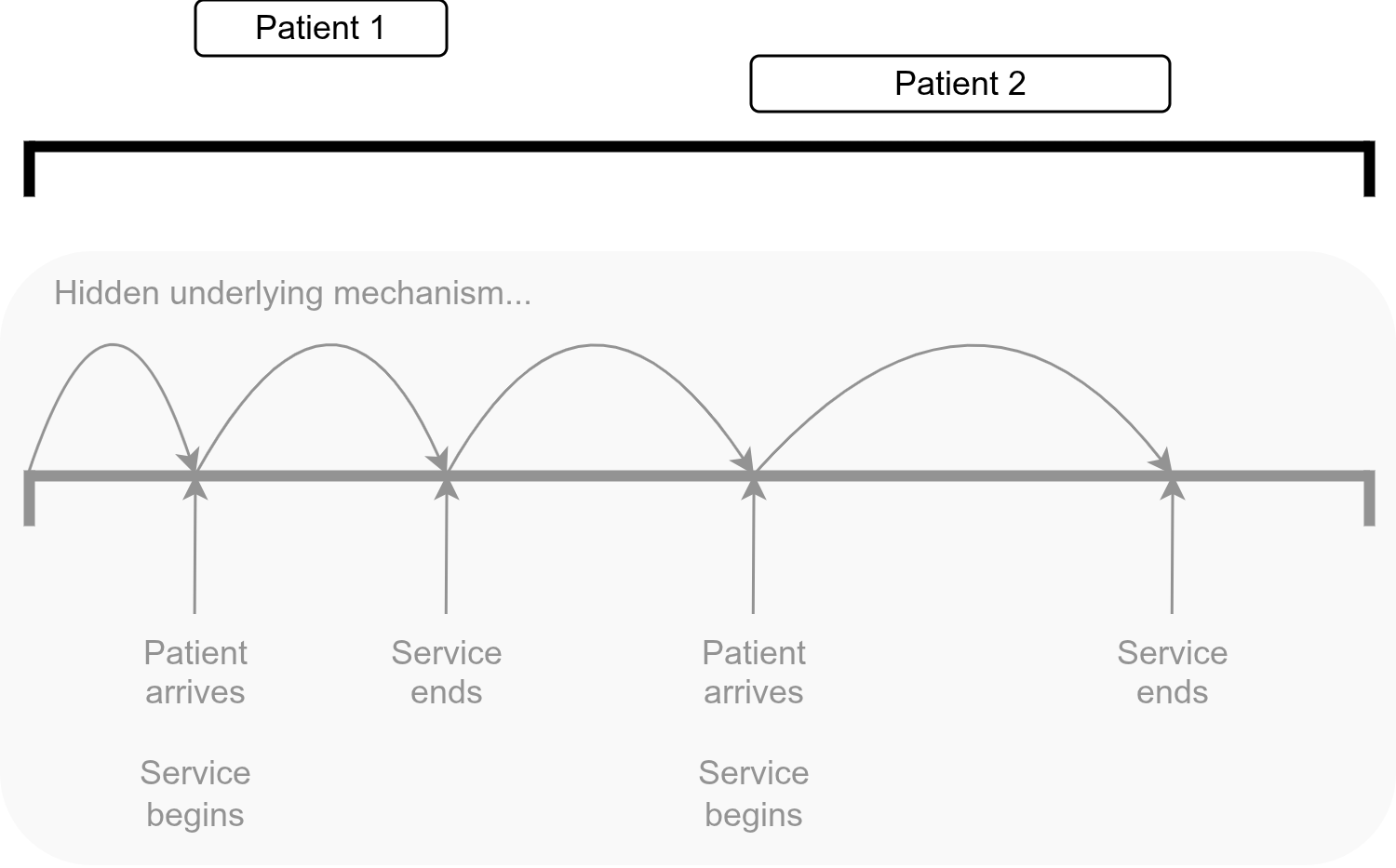Discrete-event simulation (DES)
Learning objectives:
- Understand what DES models are, how they work, and when to use them.
- Learn the core building blocks of DES models.
- Recognise the range of applications for DES in healthcare.
What is discrete-event simulation?
A simulation is a computer model that mimics a real-world system. It allows us to test different scenarios and see how the system behaves. One of the most common simulation types in healthcare is discrete-event simulation (DES).
In DES models, time progresses only when specific events happen. Unlike a continuous system where time flows smoothly, DES jumps forward between events. For example, in a clinic model, events might include a patient arriving, receiving treatment, and leaving.
Between events, the system state remains unchanged - nothing happens until the next event occurs. This makes DES well-suited for modeling systems where entities (patients, prescriptions, ambulances) move through processes and wait for resources.
Core components of DES models
All DES models share common building blocks:
| Entities | The objects that flow through the system. In healthcare, these are typically patients, but they could be other things like prescriptions, test samples, ambulances, etc. Each entity can have attributes (e.g., age, condition severity, arrival time) which affect how they move through the system. |
| Resources | The people, equipment, or facilities required to serve entities. Examples include doctors, nurses, beds, operating theatres, or diagnostic equipment. Resources have limited capacity and may serve multiple entities over time. |
| Queues | Queues form when entities wait for resources to become available. In DES models, we often track queue lengths and waiting times. |
| Activities or processes | The tasks that entities take part in. For example, this could include a 3-7 minute registration and then a 10-20 minute consultation. |
| Events | When the system changes state - e.g. a patient arrives or leaves, and an activity starts or ends. |
Randomness
Real-world systems are unpredictable: patients don’t arrive at exactly the same time, and service durations vary from person to person. To capture this uncertainty, DES models use randomness (also called stochasticity) throughout the simulation.
Instead of assigning fixed values, DES models sample from statistical distributions to determine when events happen and how long activities take.
This randomness means that every run of a DES model can produce different results, just like real life. By running the simulation many times, you can see the range of possible outcomes and understand how the system performs under different scenarios—good days, bad days, and everything in between.
How DES models advance time and handle events
As mentioned above, DES models the world as a series of events, jumping from one event to the next. When creating the model, there are several options for deciding how the simulation decides when the next event occurs and what actions to take. These are referred to as “world views” or “conceptual approaches” for building a DES model.
These definitions are based on 3.1.2 World Views from the book “Discrete-Event System Simulation” by Banks, Carson, Nelson and Nicol 2005.
Activity-based approach
The simulation advances in fixed increments (e.g., every minute). At each time step, it checks every activity to see if it can now begin (e.g., patient is waiting AND doctor is now free).
If the chosen time unit is too small, the simulation runs very slowly because it checks conditions constantly. If the chosen time unit is too large, you may miss events of lose accuracy, with activities starting late or skipped over.
Event-based approach
The simulation maintains a list of scheduled events ordered by time, known as the Future Event List (FEL). The clock jumps directly to the next scheduled event (e.g., “patient arrives at 10:15”) and executes it. After handling each event, the simulation adds any new future events to the list.
If no activities can happen right now (e.g., all doctors are busy, so the next possible event is “doctor becomes free at 10:30”), the simulation simply jumps forward in time to the next scheduled event. If the event list ever becomes empty (no future events), that’s the simulation’s signal to finish.
This approach uses variable time advancement, which is when the simulation clock jumps to the next scheduled event (rather than ticking forward in regular steps).
Process-based approach
A “process” is defined for each entity. This process describes the sequence of events and activities the entity goes through. This differs from the event-based approach, as we defining the whole journey of each entity (instead of just having a list of events).
The underlying mechanism for this approach is similar to event-based (building an FEL and using variable time advancement), but these technical details are hidden from you. Hence, process-based tools let you focus on the high-level actions and flows, without worrying about scheduling raw events manually.
This is the approach in the simulation packages used in the book - SimPy (Python) and simmer (R).
SimPy: “SimPy is a process-based discrete-event simulation framework based on standard Python.” (SimPy documentation)
simmer: “simmer is a DES package for R which enables high-level process-oriented modelling, in line with other modern simulators.” (Ucar, Smeets and Azcorra 2019)
Three-phase approach
This approach classes activities as either B-activities (bound to happen, scheduled events) or C-activities (conditional, depending on system state).
The simulation repeats three phases in sequence:
Phase A (advance time): Find the next scheduled B-event and advance clock to that time.
Phase B (execute B-events): Run all the B-events schedules for this time. This might free up resources or change system state.
Phase C (check C-activities): Scan the conditions for all C-activities. If they can begin, activate them.
This approach improves efficiency by only scanning for conditional activities at times when something has actually changed (after B-events complete), rather than scanning at every tiny time increment.
Applications of DES
Vázquez-Serrano, Peimbert-García, and Cárdenas-Barrón (2021) conducted a review of DES in healthcare, analysing over 200 published studies.
They found that the majority of studies focused on emergency departments (38.9%), medical centres (21.8%), and specific clinical conditions (13%). Other settings included clinics, intensive care units, laboratories, operating rooms, orthopaedics, pathology, paediatrics, pharmacy, radiology, and dental services.
Nearly half of the studies (49.4%) investigated time and efficiency improvements, while others addressed resource and scheduling allocation (21.2%) or financial and cost savings (12.3%).
Forbus and Berleant (2022) also did a systematic review of healthcare DES, including over 300 studies. They found that healthcare DES models could be categorised as focusing on one of four areas:
- Health care systems operations.
- Disease progression modelling.
- Screening modelling.
- Health behaviour modelling.






